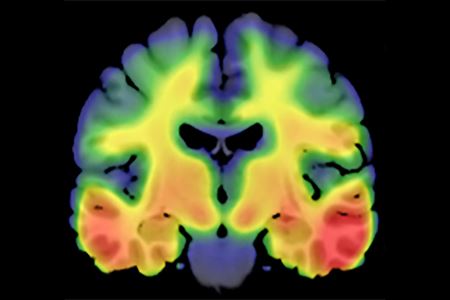INDIANAPOLIS — Indiana University School of Medicine researchers have identified a new genetic marker that could play a role in the development of Alzheimer's disease, which is characterized by two primary pathologies: amyloid-beta plaques and neurofibrillary tau tangles. Their findings, recently published in Nature Communications, could pave the way for novel therapeutic targets and diagnostic tools for the disease.
The study involved an international team of researchers who analyzed genetic and advanced tau PET imaging data from over 3,000 people, making it the largest effort to date in exploring the genetics of PET-detected cortical tau. It identified a genetic locus — the specific location of a gene on a chromosome — that accounts for a significant portion of tau deposition in older adults who have or are at risk of developing Alzheimer’s disease.
"Identifying this novel genetic marker opens a new avenue for research and potential therapeutic development by targeting an abnormal form of tau protein that comprises the tangles seen in the brain in Alzheimer's disease," said Andrew J. Saykin, PsyD, principal investigator on the study and Raymond C. Beeler Professor of Radiology at the IU School of Medicine. "While many prior genome-wide association studies compared genetic profiles of patients with Alzheimer's disease to cognitively unimpaired older adults, this study used tau PET scans as a continuous phenotype to detect a genetic locus that accounts for a significant portion of tau deposition in study participants."
Saykin, who also leads the school’s Indiana Alzheimer's Disease Research Center and the IU Center for Neuroimaging, said while previous studies have made strides in identifying genetic variants associated with amyloid deposition, understanding the genetic drivers of tau deposition has been more challenging due to the lack of large datasets with both tau PET and genetic information.
This study fills that gap, demonstrating that the rs2113389 variant located on chromosome 2p22.2, between the genes CYP1B1 and RMDN2, is strongly associated with increased tau burden across multiple regions of the brain. This variant alone explained approximately 4.3% of the variation in tau deposition, surpassing even the contribution of the widely known APOE4 gene, which accounts for 3.6%.
"Further research is needed to drill down and determine exactly what is driving this association," Saykin said. "We now have a new locus at the intersection of these genes to study as potential targets for diagnostic and therapeutic approaches."
The 3,000 participants studied were from 12 different sites around the world. Some of the individuals did not have any cognitive impairment, while others had mild or severe cognitive impairment.
"We need to replicate the findings in larger samples," said Shannon L. Risacher, PhD, co-principal investigator of the study and associate professor of radiology at the IU School of Medicine. "Most of the patient cohorts studied are based in the United States, Canada and Australia, but PET scans are conducted in many other parts of the world. A future goal would be to expand the sample size to replicate our results."
The team also plans to continue studying the locus and its behavior in mouse models.
"A very important step following the human findings is more functional validation in model systems including mice and cell cultures or organoids," said Kwangsik Nho, PhD, co-principal investigator on the study and professor of radiology at the IU School of Medicine. "We want to see if this effect can be modeled in the lab, which could greatly facilitate drug development efforts."
Saykin said combining advanced neuroimaging and genetics is something the research team has been pursuing for many years.
"It is exciting to see this approach yield a new potential target," Saykin said. "To ultimately prevent Alzheimer’s disease, we must better understand what is driving the plaques and tangles in the first place. Genetic research coupled with biomarker and cognitive studies will enable earlier detection and more precise interventions in those affected or at heightened risk."
This study was made possible through a collaborative effort between numerous research programs and institutions, including the Alzheimer's Disease Neuroimaging Initiative (ADNI) and Department of Defense ADNI; the Anti-Amyloid Treatment in Asymptomatic Alzheimer's Study; the Longitudinal Evaluation of Amyloid Risk and Neurodegeneration study; the Lilly/Avid A05 study; the Australian Imaging, Biomarkers, and Lifestyle study; the Indiana Memory and Aging Study of the Indiana Alzheimer's Disease Research Center; the Harvard Aging Brain Study; the Mayo Clinic Study of Aging; the University of Pittsburgh Alzheimer’s Disease Research Center; the Memory and Aging Project at the Knight Alzheimer's Disease Research Center; and the Berkeley Aging Cohort Study, as well other translational studies. The research was supported by multiple grants from the National Institute on Aging, the Alzheimer's Association and several other funding bodies.
About Indiana University School of Medicine
The IU School of Medicine is the largest medical school in the U.S. and is annually ranked among the top medical schools in the nation by U.S. News & World Report. The school offers high-quality medical education, access to leading medical research and rich campus life in nine Indiana cities, including rural and urban locations consistently recognized for livability. According to the Blue Ridge Institute for Medical Research, the IU School of Medicine ranks No. 13 in 2023 National Institutes of Health funding among all public medical schools in the country.
Writer: Christina Griffiths
For more news, visit the IU School of Medicine Newsroom: medicine.iu.edu/news




